Mathea Ford's Blog, page 53
January 31, 2023
Is Tuna Good For Kidney Disease?
Do you have a friend or family member who has been diagnosed with kidney disease? If so, you may be wondering what foods are best for them to eat. One food that is often recommended as part of a kidney-friendly diet for those suffering from kidney problems is tuna. But can this seafood really help someone to deal with chronic kidney issues? In this article we will explore the health benefits and potential risks associated with eating tuna if you suffer from kidney damage.
At first glance, it appears that consuming tuna could provide some benefit to those with kidney issues. Tuna contains high levels of omega-3 fatty acids and protein, both of which are important components in any healthy diet â especially when fighting off serious conditions like renal failure. Omega-3s are known to reduce inflammation in the body, while increased protein helps maintain muscle mass during times when your kidneys cannot process proteins as efficiently as they should.
But just because tuna might be beneficial doesnât mean it should be eaten indiscriminately by those living with renal illness; there are also certain considerations one must take into account before including it in their regular diet. We'll discuss these cautions more fully later on in this article - but suffice it to say that understanding how different types of tuna affect individuals differently is key to making sure that any consumption of this fish does not do more harm than good.
 Is Tuna Good For Kidney DiseaseOverview Of Tuna
Is Tuna Good For Kidney DiseaseOverview Of TunaTuna is a popular, nutritious food that many people enjoy. It's an excellent source of protein and omega-3 fatty acids, which are important for health. However, its high sodium content can be problematic for those with kidney disease. Canned tuna generally contains more sodium than fresh or frozen varieties. The exact amount may vary depending on the brand and type of canned tuna purchased.
Nutrition labels provide information about the sodium content in tuna products. Some brands of canned tuna have as much as 200 milligrams of sodium per 2 ounces, while others have only 25 milligrams per 2 ounces. Additionally, itâs important to note that some types of canned tuna contain added salt or other seasonings that can further increase the total sodium content.
It's essential to carefully read nutrition labels when selecting any kinds of fish but especially when considering canned tuna due to its higher levels of sodium compared to fresh or frozen options. With this knowledge, individuals who must watch their intake of sodium can make better choices for their health needs. Next, we'll examine the nutritional benefits of tuna.
Nutritional Content Of TunaTuna is a versatile fish, and its nutritional content reflects this. Like all seafood, it is high in protein, containing about 24g of protein per 100g portion size canned tuna. It's also low in saturated fats â just 1 gram for every 100 grams â making it an excellent choice for those looking to maintain heart health through their diet. Moreover, tuna contains generous amounts of various vitamins and minerals including omega-3 fatty acids and zinc, as well as potassium.
100 grams of tuna is equal to approximately 3.5 ounces of cooked, drained tuna. Some varieties of canned tuna contain added ingredients like oil or water, so the exact amount may vary slightly depending on the type of tuna you are consuming.
In terms of the macronutrients that make up our daily diets, tuna packs quite a punch: 1. Protein - 24g /100g 2. Fat - 6 g/100g 3. Carbohydrates - 0 g/100g 4. Potassium - 363 mg/100g
This nutrient profile makes tuna a great addition to any balanced meal plan â especially if you're living with kidney disease or other conditions where sodium intake needs to be monitored closely. The lack of carbs make it suitable for those on diabetic diets. The high protein content also means your body will get all the amino acids it needs without having to rely too heavily on other animal products like red meat or eggs. Finally, there are many ways to enjoy tuna; whether raw (sushi), canned, smoked or cooked into casseroles and salads!
For more recipes and ideas, CLICK HEREÂ and get your free meals and recipes that are perfect for Pre-Dialysis diets, Pre-Dialysis With Diabetes diets, or Dialysis diets.Impact On DiabetesTuna is an excellent choice for a diabetic's diet. It is low in fat and calories, making it an ideal source of protein to help manage weight gain associated with diabetes. Furthermore, tuna contains omega-3 fatty acids, which can reduce inflammation and improve blood sugar control in those with type 2 diabetes. If you are considering adding tuna to your diabetic diet plan, here are some things to keep in mind:
First, look for canned light tuna packed in water rather than oil or brine solutions. This will limit the amount of added sodium that might otherwise be present. Second, watch how much tuna you consume as part of your overall meal plan; too much could lead to excess calories that may cause weight gain over time. Finally, if you are looking for ways to include even more healthy fats into your diet plan, consider pairing tuna with other sources such as olive oil or avocado when preparing meals.
In terms of its impact on diabetes specifically, research suggests that consuming fish like tuna two times a week can improve glycemic control and lower risk factors associated with heart disease among diabetics. Additionally, this same research found that consuming tuna was linked to improved insulin sensitivity - something beneficial for those who have difficulty controlling their blood glucose levels after eating carbohydrates.
When it comes to nutrition content, tuna is rich in protein and potassium â both essential nutrients for managing diabetes symptoms effectively.
Protein And Potassium ContentIt's no secret that tuna can be a great addition to any diet, but does it have benefits for those with kidney disease? Let's dive in and find out.
Protein is essential for repairing tissue and maintaining muscle mass, which makes it an important nutrient for people suffering from kidney disease. Fortunately, canned tuna can provide plenty of protein - on average about 17 grams per 3-ounce serving. This means that eating just one can of tuna provides over half the daily recommended protein intake!
Potassium plays a key role in heart health and bone strength, so ensuring you get enough through your diet is crucial - particularly when dealing with kidney issues. Luckily, canned tuna offers up around 170 milligrams of potassium per 3-ounce serving. That said, some types of canned tuna may contain more than others due to added ingredients like brine or oil.
Sodium Content In Canned TunaAs discussed previously, protein and potassium content are important considerations when evaluating the nutritional value of canned tuna for those with kidney disease. Sodium content is also an essential factor to consider given its potential impact on hypertension levels. So how much sodium is in canned tuna? The answer varies depending on whether it is packed in water or oil.
Canned tuna packed in water typically contains around 200mg of sodium per 3-ounce serving, while those packed in oil contain approximately 400mg per 3-ounce serving. This means that individuals with kidney disease should opt for tuna packed in water if they have heightened concerns about their salt intake. It's worth noting that regular consumption of canned tuna may not be suitable for some individuals because of its high sodium content.
Itâs important to note that even when selecting options low in sodium, dietary considerations with kidney disease must still be taken into account due to other nutrients such as phosphorus and potassium which can affect renal function. As a result, consulting with a healthcare professional before consuming any type of seafood regularly is highly recommended. With this advice at hand, it will help ensure the diet chosen best meets individual needs while providing adequate nutrition for optimal health outcomes.
Dietary Considerations With Kidney DiseaseNavigating the dietary landscape with kidney disease can be a daunting task, but it doesn't have to feel like you're wandering through an impenetrable fog. Like a lighthouse beacon piercing the darkness, understanding what foods are safe and beneficial for your kidneys is key. So, is tuna good for kidney disease? Let's take a look!
First off, if you have chronic kidney disease (CKD) or end-stage renal disease (ESRD), it is wise to limit fish intake due to the potential of heavy metals such as mercury that could accumulate in your body over time. However, when consumed in moderation, certain types of fish â especially lower-mercury varieties like light canned tuna â may actually provide some health benefits for those with CKD or ESRD.
Tuna has been linked to improved cardiovascular health and reduced inflammation. It is also high in omega-3 fatty acids which help protect against various heart diseases. Plus, because canned tuna is low in phosphorus and potassium levels, it can be safely eaten by individuals who need to restrict their intake of these minerals due to impaired kidney function.
In summary, eating light canned tuna on occasion can be part of a healthy diet for people with kidney disease; however always talk to your doctor before adding any food item into your regular routine. Now let's explore the many health benefits of consuming this versatile seafood dish!
Health Benefits Of Eating TunaKidney disease can be a difficult condition to manage, and diet plays an important role in protecting kidney health. Fortunately, tuna is one of the foods that can provide some benefits for people with kidney disease. Tuna contains beneficial nutrients like protein and omega-3 fatty acids, which are key components of healthy eating plans. It also has relatively low levels of sodium compared to other types of fish.
Tunaâs high content of essential omega-3 fatty acids makes it a great source of nutrition for those with kidney disease who need more heart-healthy fats in their diets. Omega-3s help lower cholesterol levels and reduce inflammation throughout the body, both factors associated with improved renal function. Additionally, studies have shown that consuming enough omega-3 fatty acids may even protect against chronic diseases like diabetes, hypertension, cancer and Alzheimer's Diseaseâall conditions commonly found alongside kidney dysfunction.
All these nutritional benefits make tuna an ideal choice for anyone seeking out better ways to improve their overall health and well being without sacrificing flavor or texture. But before adding this tasty seafood into your meal plan there are potential dangers associated with eating canned tuna that should be considered too...
Potential Dangers Of Eating Canned TunaBefore we all go out and stock up on tuna for dinner, let's take a closer look at the potential dangers of eating canned tuna. While it can be convenient and delicious, there are some things you should know before consuming this fishy snack.
First off, how much sodium is in a can of tuna? A single three-ounce can contains about 200 milligrams (mg) of sodium - thatâs almost 10 percent of your recommended daily intake! Furthermore, if you opt for âlightâ or âlow-sodiumâ varieties, they may still contain around 130 mg per serving. So while light canned tuna might seem like the healthier option, unfortunately that isn't necessarily true.
To make matters worse, many brands add preservatives to their products which also contributes to high levels of sodium in each can. Here's a quick list with more details:
* Light Canned Tuna: Approximately 130 mg/3 ounces
* Regular Canned Tuna: About 200 mg/3 ounces
* Flavored Canned Tuna: Upwards of 400 mg/3 ounces
* Preserved Canned Tuna: Over 500 mg/3 ounces
Mercury levels can also be a concern when it comes to eating tuna, as tuna is known to contain higher levels of mercury than other types of fish. High levels of mercury can be dangerous, as it is a neurotoxin that can cause long-term health issues.
To address this concern, it is important to be aware of the mercury levels in different types of tuna, as some fish contain more mercury than others. Light canned tuna, for example, generally contains much lower levels of mercury than albacore tuna. It is also important to limit the amount of tuna you consume, as larger fish tend to contain higher levels of mercury.
Additionally, it is important to look for tuna that is certified by the Marine Stewardship Council (MSC). This logo indicates that the tuna has been caught in a responsible way, and that it has been tested for mercury levels.
Finally, it is important to be aware of other sources of mercury, such as certain types of seafood and certain types of fish. If you cannot find tuna that has been tested for mercury levels, it is best to avoid certain types of fish altogether.
Safe Preparation Tips For Eating TunaEating tuna can be a healthy part of a diet for people with kidney disease, but there are some important preparation tips to keep in mind. One common concern is whether canned tuna is bad for those with kidney disease. Fortunately, canned tuna can still be enjoyed as long as the sodium content of the product is taken into account. Additionally, it's best to avoid eating raw or undercooked fish since this could potentially contain bacteria and parasites that may harm someone with weakened kidneys.
When preparing fresh tuna at home, make sure to cook thoroughly until its internal temperature reaches 145°F (62°C). This will help ensure any potential harmful contaminants are destroyed during cooking. It's also important to note that while most types of tuna are safe for those with kidney issues, certain species like albacore should be avoided due to higher levels of mercury contamination in these varieties.
By following these simple guidelines when consuming tuna, people living with kidney disease can enjoy this nutritious seafood option without worrying about their health. With careful selection and proper preparation techniques, individuals can reap the many benefits associated with eating tuna safely and effectively. Now letâs take a look at alternative fish options for people with kidney disease.
Alternative Fish Options For People With Kidney DiseaseFor people with kidney disease, fish can be a great source of nutrition. But tuna is not always the best option, as it has some risks that should be considered.
When considering alternative fish options for people with kidney disease, there are certain types of fish that provide more beneficial nutrients than others. For example, salmon is rich in omega-3 fatty acids which have shown to reduce inflammation and improve heart health; while mackerel is an excellent source of protein without high levels of mercury or salt content like canned tuna often contains. Additionally, herring and sardines are both low in fat but contain healthy fats such as EPA and DHA which support brain development.
In comparison to these healthier alternatives, tuna does not offer the same level of nutritional benefits since it tends to be higher in calories and saturated fat than most other types of seafood. Furthermore, because canned tuna typically includes added ingredients such as oil and salt, these additional components can increase fluid retention in those with pre-existing conditions such as kidney disease or diabetes. Therefore when deciding on what type of fish to include in oneâs diet it is important to consider the nutrient profile along with any potential side effects from consuming too much sodium or other unhealthy additives found in processed foods like canned tuna.
Changes In Diet To Accommodate Kidney Disease SymptomsRestricting certain foods and drinks can be a critical component in managing kidney disease. For this reason, many people with kidney conditions must consider their diet choices carefully. A can of tuna may provide high-quality protein for those living with the condition, but caution is required when it comes to sodium content.
It's important to note, however, that some varieties of tuna come packed with added flavors or seasonings that could increase the amount of sodium present even further. Before buying any canned fish product, make sure you read the nutritional label closely so you'll know exactly what you're getting. With careful consideration and planning, it is possible for those dealing with kidney problems to still enjoy an occasional can of tuna as part of a balanced meal plan.
Effects Of Omega-3 Fatty Acids On Kidney HealthOmega-3 fatty acids are important for overall health, especially kidney health. They can reduce inflammation and may even slow down the progression of some chronic diseases like kidney disease. But does tuna have enough omega-3 fatty acids to make a difference? Letâs explore this further by looking at the nutritional content of tuna.
A 3 ounce portion of food contains approximately 16 grams of protein, 0 grams of carbohydrates, 5 grams of fat, 180 mg of sodium, 180 mg of potassium, 180 mg of phosphorus, and 0.3 grams of omega 3 fatty acids. This combination of nutrient values provides a balanced source of essential proteins and fats, with a moderate amount of carbohydrates, to ensure that your body is supplied with the building blocks it needs for a healthy lifestyle. Additionally, the sodium, potassium, and phosphorus are all important minerals that help to regulate bodily functions, while the omega 3 fatty acids provide essential fatty acids to support healthy brain function.
This amount may be beneficial as it can help lower blood pressure levels while providing essential nutrients that are needed for healthy kidneys. Additionally, since protein helps maintain muscle mass and strength, having an adequate amount also ensures optimal functioning of your kidneys as they require energy to do their job properly.
Since omega-3 fatty acids play an important role in reducing inflammation associated with many chronic illnesses such as kidney disease, eating foods high in these fats could be beneficial for those suffering from this condition. Tuna might not provide large amounts but its contribution should still be taken into account when creating a balanced diet plan tailored specifically towards supporting better kidney health. A combination of other sources such as fish oil supplements or walnuts will help increase daily intake significantly so consider adding them if possible too!
Frequently Asked QuestionsHow Much Tuna Should I Eat If I Have Kidney Disease?When it comes to making food choices for people on a renal diet, tuna is an option that may be beneficial. However, the amount of tuna you should eat depends on your individual needs and health condition. It's important to speak with your doctor or a registered dietitian about how much tuna is appropriate for you.
Tuna is high in protein and low in phosphorus. Protein plays an essential role in maintaining healthy tissues, while phosphorus can build up in the blood of those with chronic kidney disease (CKD) and eating a renal diet. So by limiting phosphorus-rich foods like red meat and dairy products, eating more fish like tuna can help keep levels balanced. Additionally, tuna contains omega-3 fatty acids which have been found to improve cholesterol numbers and reduce inflammation associated with CKD.
In order to determine how much tuna is right for you, consulting with your healthcare team is recommended. They will help assess how far along your CKD has progressed and provide guidance around dietary modifications that are tailored to meet your specific needs. By doing this, they can ensure that you're getting enough nutrition without overloading your system with too many nutrients or toxins found in certain types of seafood. With their advice and support, including tuna in moderation as part of a well-balanced diet plan could potentially offer some positive benefits when living with kidney disease.
Eating right is the key to good health, especially for those with kidney disease. Tuna is a popular seafood choice, but it may not be the best option when it comes to maintaining healthy kidneys. So what are some of the best alternatives to tuna for people with kidney disease?
First and foremost, itâs important to note that if you have any kind of chronic condition like kidney disease, then consulting your doctor before making dietary changes is essential. With that said, here are some delicious and nutritious options: * Seafood: * Salmon * Anchovies * Mackerel * Vegetarian Options: * Lentils * Beans * Quinoa
All three categories provide excellent sources of protein and other nutrients without being too hard on the kidneys. For example, salmon is an excellent source of omega-3 fatty acids which helps reduce inflammation in the body while beans contain fiber that can help maintain blood sugar levels. Additionally, mackerel provides plenty of iron as well as vitamins A and B12 which help keep energy levels up throughout the day.
When looking for alternatives to tuna for people with kidney disease, there's no shortage of delicious and nutritious options available. Finding something tasty isn't difficult at all â just make sure to check with your doctor first about any dietary restrictions or suggestions they may have!
Tuna is an incredibly versatile food that can be prepared in a variety of ways, from sushi to casseroles. But for people with kidney disease, the question arises: Is canned tuna better or worse than fresh tuna? To answer this question, it's important to consider both nutritional value and preparation methods.
First off, letâs look at nutrition. Canned tuna typically has more calories per serving as well as higher levels of omega-3 fatty acids which are beneficial for overall health. On the other hand, fresh tuna tends to have fewer calories but also contains less of these healthy fats. So when considering nutrition alone, there isn't necessarily one type of tuna that stands out above the rest.
When it comes to preparation methods though, things get a bit trickier. Since canned fish is already cooked before being put into cans, they tend to make simpler meal options compared to fresh fish. This can be helpful when dealing with limited kitchen resources or time constraints; however if you're looking for something closer to its natural state then fresh tuna might be the way to go.
It's also important to note that certain types of canned fish may contain preservatives like salt and oil which could potentially worsen symptoms associated with kidney disease depending on individual cases.
{Here's a quick summary:}
1. Nutritional value between canned and fresh tuna is comparable 2. Canned tuna provides easier meals while still containing some nutritious benefits 3. Fresh tuna offers more of its original state but requires cooking effort. No matter what type of tuna you decide upon, it's always best practice talk through dietary choices with your healthcare provider first so they can tailor advice specifically for your needs!
When pregnant, it can seem like so much is off limits due to the health of both you and your baby. If you are also dealing with a kidney disease diagnosis, eating tuna may be an added concern. But fear not - there are some guidelines that can help make sure you eat safely while expecting.
First things first: what type of tuna should someone with kidney disease avoid? Canned tuna has higher levels of mercury than fresh tuna, which means that pregnant women and those with pre-existing conditions such as kidney disease should limit their canned intake. Fresh tuna, on the other hand, contains low amounts of mercury and is safe for general consumption in moderation.
So how much could someone with kidney disease safely consume? Experts recommend no more than two 6-ounce servings per week for adults who have healthy kidneys; however, if you have advanced stages of chronic kidney disease (CKD), it's best to consult with your doctor or dietitian before consuming any amount of seafood. They'll be able to give personalized advice based on your individual health concerns and dietary needs.
Tuna isn't just for sandwiches - by adding it into meals like casseroles, salads, and pastas, you can enjoy its deliciousness without having to worry about overdoing it. Keep in mind that even though moderate portions are generally okay for people with CKD, too much fish might create further problems due to high phosphorus content found in most types of seafood. So play it safe - check in with your doctor before diving into a plate full of seafood!
The best methods for preparing tuna for people with kidney disease depend on the individual needs of the patient. As the adage goes, "one size does not fit all," and this is especially true when it comes to health-related diets. Whether someone has diabetes or chronic kidney disease, an individualized approach can often be beneficial in ensuring that a person gets the nutrients they need while managing their condition.
When it comes to tuna specifically, there are several ways to prepare it to ensure maximum nutritional benefit without causing further damage to already weakened kidneys. To begin, it's important to choose high quality canned or fresh tuna; these options generally contain fewer additives than processed varieties, which could negatively affect those with compromised renal function. Itâs also essential to consider sodium levels since too much salt intake can worsen symptoms associated with kidney failure.
For those who have difficulty controlling sodium levels, limiting fish consumption may be necessary; however, if possible, here are some creative ideas for eating tuna:
* Baking Tuna:
* Stuffed Peppers - Stuff peppers with cooked brown rice, vegetables and canned tuna then top with grated cheese before baking.
* Fishcakes - Combine mashed potatoes, cooked veggies and flaked canned tuna then shape into patties before frying in a low-fat oil such as olive or sunflower seed oil until golden brown.
* Grilling/Barbecuing Tuna:
* Skewers - Alternate cubes of marinated raw tuna onto skewers alongside your favorite vegetables â onion slices, bell pepper pieces etc., â then grill over medium heat until just cooked through (about 3 minutes per side).
* Wraps - Grill pre-marinated raw tuna steaks wrapped in foil then serve inside warm tortillas along with lettuce leaves and sauces like tahini yogurt dressing.
No matter what cooking method you choose, always make sure that everything is thoroughly washed beforehand and that it's prepared using healthy ingredients such as herbs and spices rather than oils or fats which could increase overall fat content and cause complications related to heart health or renal diseases. With careful consideration of dietary guidelines combined with proper preparation techniques tailored towards individuals' specific needs, everyone can enjoy delicious meals featuring one of nature's most nutrient dense fishes!
I have learned that tuna can be beneficial for those with kidney disease, depending on how much is eaten and the type of tuna one consumes. For some people, canned tuna may be a better option than fresh tuna due to its lower levels of phosphorus and other minerals. However, pregnant women should avoid eating any kind of tuna if they are suffering from kidney disease.
The best way to ensure you are getting all the nutrition your body needs while still safely consuming tuna is to prepare it properly. This includes steaming or poaching rather than baking or frying as this will reduce the amount of fat in your meal. Additionally, make sure that you season your fish lightly so as not to overload your kidneys with salt or pepper.
In conclusion, when consumed responsibly and in moderation, tuna can be an excellent source of protein for those who suffer from kidney disease. Remember to always follow the advice given by your doctor and dietician regarding what types and amounts of food are safe for you. Eating well-prepared meals including fish such as tuna can help manage kidney health more effectively.
The post Is Tuna Good For Kidney Disease? appeared first on Renal Diet Menu Headquarters.
Suggested Reading:
Fish Oil, Omega 3s, and Kidney Disease, Yay or Nay? What Fish to Eat With Kidney DiseaseJuly 4, 2022
How To Improve Bun Levels
What Are BUN Levels & What Do They Measure?
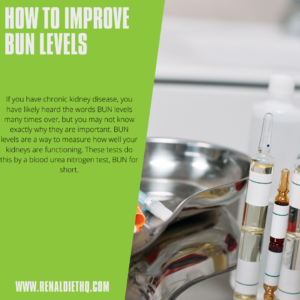 If you have chronic kidney disease, you have likely heard the words BUN levels many times over, but you may not know exactly why they are important. BUN levels are a way to measure how well your kidneys are functioning. These tests do this by a blood urea nitrogen test, BUN for short.
If you have chronic kidney disease, you have likely heard the words BUN levels many times over, but you may not know exactly why they are important. BUN levels are a way to measure how well your kidneys are functioning. These tests do this by a blood urea nitrogen test, BUN for short.
Urea nitrogen is a waste product that comes from the liverâs process of breaking down proteins in the body. Your kidneys are a key component in removing toxins and waste from the body, and one of the things they remove is urea nitrogen.
So, if your BUN levels are increasing, it shows signs that your kidneys are not properly removing this waste and can indicate kidney damage. For those with chronic kidney disease, it can be used as a way to measure improvements or further damage that may be affecting your kidney function.
Why Would You Get the BUN Test?
There are many reasons that your physician may order a BUN test for you, but most of them have to do with the kidneys and the liver. According to Healthline, this test can be used to diagnose many different conditions that involve these organs and others, such as liver damage, malnutrition, dehydration, urinary tract issues, congestive heart failure, and even bleeding in the abdominal tracts.
What Is the Normal BUN Level Range?
The normal level of BUN ranges from 8 to 24 mg/dL for adult men, 6 to 21 mg/dL for adult women, and 7 to 20 mg/dL for children from ages 1 to 17.
What BUN Level Indicates Kidney Failure?
Increases in BUN levels can indicate kidney damage or kidney failure; ranges that may indicate an issue can start at above 20 to 24 mg/dL, as this is outside of the expected normal range. Any higher levels of BUN from your blood tests should be discussed with your physician, and they can fully assess what these results may mean for you and your kidney health and renal function.
How To Improve Your Blood Urea Nitrogen (BUN) & Creatinine Levels
Drink A Lot of Water
Drinking a lot of fluids may be hard to do if you are on dialysis, so it is important to discuss a safe amount of fluid intake per day with your physician and your dietician. This is especially important when considering ways to reduce your creatinine ratios and blood urea nitrogen levels because dehydration is a major cause of increased BUN levels.
When you are dehydrated, you are getting less water reabsorbed from your other fluid or food intakes. This results in an increase rate in urine which has high levels of urea nitrogen and other waste products. If you are well hydrated, you have excess water in your system, which gets removed during urination, but if you are dehydrated, your body holds onto and removes any water from the waste, and your urea levels and other waste levels increase due to the urineâs waste content increase.
This is why your urine appears darker when you are dehydrated. Hydration is important to decrease your BUN levels because it helps flush out any additional waste products and helps lower the urea concentration in the kidneys and the blood.
Reduce Protein Intake
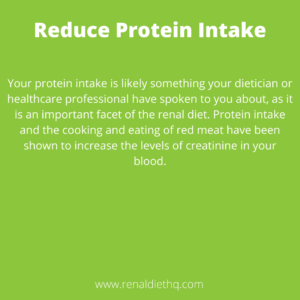 Your protein intake is likely something your dietician or healthcare professional have spoken to you about, as it is an important facet of the renal diet. Protein intake and the cooking and eating of red meat have been shown to increase the levels of creatinine in your blood.
Your protein intake is likely something your dietician or healthcare professional have spoken to you about, as it is an important facet of the renal diet. Protein intake and the cooking and eating of red meat have been shown to increase the levels of creatinine in your blood.
Protein, red meat, and dairy can increase your creatinine levels, which is why those who are on a renal diet usually pay close attention to their protein intake. If you are looking for ways to decrease these levels, you should eliminate red meat entirely and make healthy replacements for any protein or dairy-heavy parts of your meals.
Increase Fiber Intake
Eating fiber is good for many different things, such as healthy bowel movements, helps to regulate blood sugar, lowers cholesterol, and can help to lower creatinine levels. Increasing your fiber intake while sticking to your renal diet is a great way to help lower these levels and help regulate your digestion and other issues you may have, such as diabetes or other health complications.
What Causes High BUN & Creatinine Levels?
As we have covered above, high blood urea nitrogen and creatinine levels can be caused by liver damage and kidney damage. However, if you are already diagnosed with chronic kidney disease, then a further increase in these lab tests can be caused by a multitude of other reasons as well. Some of these reasons for a sudden increase could be that you have been eating a lot of protein or red meat, you have a fever or other infection present that you may not have been aware of, you could be dehydrated, stressed, or you could be suffering from poor circulation.
What Are The Symptoms of High Blood Urea Nitrogen?
Frequent Urination (or lack of)
One of the symptoms of high blood urea nitrogen has to deal with the amount of urination you are experiencing. Increased BUN and creatinine levels can result in an increase in urination or a decrease in urination. Any change from your normal routine should be noted and brought up at your next appointment with your physician.
If you have chronic kidney disease, these issues may be more prevalent. If you are urinating a lot, you could be making yourself dehydrated by the loss of water through these processes. If you are not urinating as much, you could be increasing the urea levels by not excreting as much of this waste as you should, which could also cause dehydration.
Exhaustion
Exhaustion and fatigue can be a symptom of high BUN, and elevated creatinine levels as the increase of waste products can cause you to feel sluggish. If you are a patient with chronic kidney disease and you have been feeling unusually sluggish or exhausted, you should schedule an appointment with your physician to check your BUN and creatinine levels.
If you have an increased amount of these waste products that your kidneys have not been able to remove from your body, these tests will be higher, and you may require medication or a renal diet change.
Swelling of the extremities
Much like some of our other symptoms on this list, swelling of the extremities can indicate an issue of dehydration or further kidney damage. This is also a symptom of high BUN and creatinine levels, and should be addressed by your doctor immediately. If you are a patient on dialysis, you are probably familiar with the fact that the swelling of the arms and legs can indicate something known as retention.
Retention is indicative of end-stage renal failure, and dialysis patients must go to regular dialysis appointments to avoid this serious condition. Swelling and retention is a symptom of high BUN levels and creatinine because it indicates that the kidneys are not successfully removing excess wastes, toxins, and fluids from the body.
If you are struggling with high BUN levels, there are actions you can take to try to decrease your blood urea nitrogen and creatinine levels.
An increase in BUN levels or creatinine levels may cause you stress, but there are a few simple explanations and tips for why they may be raised and how you can decrease them. It is essential to discuss any dietary changes or new symptoms with your physician so that you can implement some of their tips and ours at home to improve these levels!
The post How To Improve Bun Levels appeared first on Renal Diet Menu Headquarters.
Suggested Reading:
CKD Creatinine Lab Values, What You Need To Know! What Is eGFR (Estimated Glomerular Filtration Rate) In Blood Test Results? What Does It Mean For Chronic Kidney Disease? Laboratory Exams For Chronic Kidney Disease:CHRONIC KIDNEY DISEASE LABSJune 28, 2022
Can Dialysis Patients Drink Alcohol
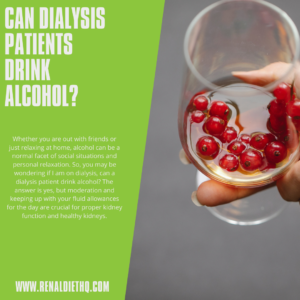 Whether you are out with friends or just relaxing at home, alcohol can be a normal facet of social situations and personal relaxation. So, you may be wondering if I am on dialysis, can a dialysis patient drink alcohol? The answer is yes, but moderation and keeping up with your fluid allowances for the day are crucial for proper kidney function and healthy kidneys.
Whether you are out with friends or just relaxing at home, alcohol can be a normal facet of social situations and personal relaxation. So, you may be wondering if I am on dialysis, can a dialysis patient drink alcohol? The answer is yes, but moderation and keeping up with your fluid allowances for the day are crucial for proper kidney function and healthy kidneys.
Speaking with your dietician about the inclusion of occasional alcohol intake into your current diet and fluid schedule will be important as a renal patient. Alcohol can dehydrate your system and further damage your kidneys if it is consumed in excess. Your kidneys cannot regulate the excess alcohol as well as others without CKD, so it is important to drink responsibly and in moderation to avoid kidney disfunction and kidney failure.
Is Alcohol Bad For Kidneys?
Many things can be damaging to your body if ingested in excess, and alcohol is no different. Further kidney damage, liver damage, fluctuations in blood sugar levels, inhibition of medications, and many other issues and harmful effects can arise from the continued and excessive consumption of alcohol. However, when drinking in moderation and keeping up with your diet and how your body feels, these effects are not prominent issues for most casual drinkers.
How Does Alcohol Affect the Kidneys?
Alcohol affects the kidneys by further impairing their ability to filter out toxins and waste properly. Those with chronic kidney disease already have damage to their kidneys which causes these problems, and excessive alcohol consumption worsens these issues. So, while dialysis patients can drink alcohol, it is important to know how it may affect your body if you drink in excess and to avoid that.
Liver damage, such as cirrhosis, has long been the most notable side effect of alcoholism, but the damage that occurs to the liver can also worsen the damage of our kidneys as well. The liver and kidneys work together to regulate the flow and filtration of the blood, and when the liver is damaged, the kidneys can get overrun by the extra workload of filtering out the toxins and waste.
Alcohol can also raise blood pressure, lower blood sugar, and disrupt medications such as those for hypertension. Alcohol can also be very dehydrating, which also increases toxins and wastes in the body. While you may have increased urination, you are getting rid of important water content your body needs and making your kidneys work harder to purge your body of those additional toxins.
Can Dialysis Patients & CKD Patients Drink Alcohol?
Can Dialysis Patients Drink Beer?
Dialysis patients are able to drink beer, but it must be included in their daily fluid allowance. It is important to talk to your dietician and healthcare providers to really figure out a personalized fluid intake schedule for your stage of kidney disease and to talk about the effects of alcohol if you are a casual beer drinker.
Can Dialysis Patients Drink Wine?
Dialysis patients can drink wine, and drinking in moderation rarely causes problems for those with CKD. However, it is important to not exceed the limit of ounces of wine set by your dietician and your physician.
How Much Alcohol Can Dialysis Patients Drink?
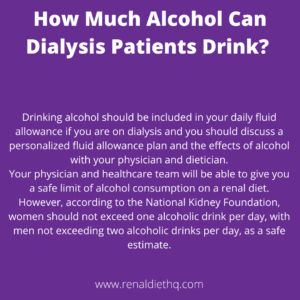 Drinking alcohol should be included in your daily fluid allowance if you are on dialysis and you should discuss a personalized fluid allowance plan and the effects of alcohol with your physician and dietician.
Drinking alcohol should be included in your daily fluid allowance if you are on dialysis and you should discuss a personalized fluid allowance plan and the effects of alcohol with your physician and dietician.
Your physician and healthcare team will be able to give you a safe limit of alcohol consumption on a renal diet. However, according to the National Kidney Foundation, women should not exceed one alcoholic drink per day, with men not exceeding two alcoholic drinks per day, as a safe estimate.
The Best Types of Alcohol To Drink On DialysisGin and Tonic
An allowance of about 1.5 ounces of distilled spirits, is the alcohol limit for many dialysis patients. The best drinks tend to be clear liquors and a pairing such as tonic water or club soda. These types of drinks will help to prevent dehydration and contain, on average, only 12 milligrams of potassium and 2 milligrams of phosphorus.
White Wine
Wine is a popular drink of choice for those going out to dinner or at social celebrations. While you have the choice of red or white, and the potassium and phosphorus levels will vary by the type of wine, white wine is generally the better option. While red wine may contain many antioxidants, white wine usually has fewer phosphates and lower levels of potassium. Wine intake should be limited to 5 ounces a day for most choices.
Martini
Much like the vodka tonic or gin and tonic options, a martini has some of the lowest levels of potassium and phosphorus among mixed drinks. This option will help less with dehydration as it only includes the spirits themselves and no added water.
Alcoholic Drinks To Avoid on Dialysis
Pina Colada
Many of the drinks which should be avoided on this list are due to the fact that the ingredients usually contain high levels of potassium and phosphorus. Pina Coladas generally include fruit and mixer ingredients that are high in potassium and sugars.
Tequila Sunrise
Much like the Pina Colada above, the Tequila Sunrise includes syrups and processed citrus-like orange juice, which add a lot of potassium to one small drink.
Bloody Mary
While Bloody Maryâs may seem like they would be relatively safe as an alcohol option for dialysis patients, use of most tomato juices and mixers has a lot of added potassium, and many of them also contain a large amount of sodium.
Yes, dialysis patients can drink alcohol, but it is particularly important they monitor their intake, even more so than the average person.
While dialysis patients can enjoy an occasional alcoholic beverage, it is important to keep up with your fluid intake and discuss your consumption of alcohol with your physician to promote kidney health. Alcohol can have many negative effects on your kidneys if you drink in excess so it is important to only drink in moderation and to choose drinks that still allow you to maintain reasonable potassium, sodium, and phosphorus levels.
The post Can Dialysis Patients Drink Alcohol appeared first on Renal Diet Menu Headquarters.
Suggested Reading:
Alcohol and Kidney Disease – Can I Have A Beer? Renal Diet Podcast 064 – Alcoholic Beverages and Renal Disease Alcohol and Kidney DiseaseJune 20, 2022
Oatmeal & Your Renal Diet: What You Need To Know
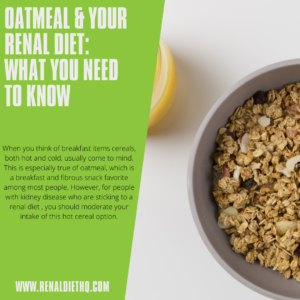 When you think of breakfast items cereals, both hot and cold, usually come to mind. This is especially true of oatmeal, which is a breakfast and fibrous snack favorite among most people. However, for people with kidney disease who are sticking to a renal diet , you should moderate your intake of this hot cereal option.
When you think of breakfast items cereals, both hot and cold, usually come to mind. This is especially true of oatmeal, which is a breakfast and fibrous snack favorite among most people. However, for people with kidney disease who are sticking to a renal diet , you should moderate your intake of this hot cereal option.
Oatmeal can contain high levels of potassium and phosphorus, which can be dangerous to those on a renal diet if they are eaten in excessive amounts. This is because the kidneys do not function properly to get rid of the excess amounts of these minerals and nutrients. So, oatmeal is a healthy choice, but it should be eaten in moderation to promote healthy kidney function!
Can You Have Oatmeal On a Renal Diet?
Is Oatmeal Good For Kidneys & a Renal Diet – Yes or No?
Oatmeal is a healthy hot cereal choice that contains a lot of fiber, but it can also contain high levels of potassium and is a high source of phosphorus, which are not ideal for those with a renal disease. So, if you are asking yourself if you can eat oatmeal on a renal diet, the answer is yes but only in moderation!
This can be a healthy, natural source of fiber for your diet, but the nutritional values should be measured, and the amounts of phosphorus and potassium should be documented, so your intake is not in excess for your kidneys.
Is Oatmeal High In Phosphorus?
Yes, many oatmeals contain a high level of phosphorus, but this may not be a complete deterrent from this healthy breakfast option. This is because much of the phosphorus found in oatmeal is actually bound to the phytates in the oat grains themselves.
Phytates are actually the bound versions of phosphorus that exist in things like unprocessed whole grains. This means that it is actually an anti-nutrient that prevents the absorption of the bound versions of phosphorus in the grains.
So, while there is a high level of phosphorus, not all of that will be absorbed into your body. Though it is still important to eat it in moderation and maintain a check of the phosphorus you are ingesting, you can eat oatmeal on a kidney diet.
Is Oatmeal Low in Potassium?
Oatmeal is generally higher in potassium than other cereal choices. However, most single servings contain low enough amounts of this mineral that they are not considered to be a completely off-limits option for those sticking to kidney friendly or general low potassium diets. A single cup of oatmeal can be anywhere from 120 to 180 milligrams of potassium, so it is important to look into the nutrition facts of different brands and to keep track of your overall potassium intake for each day. With all of these things in mind, oatmeal is okay for those with chronic kidney disease to eat while on a renal diet.
How Much Oatmeal Is Okay To Eat When You Have Kidney Disease?
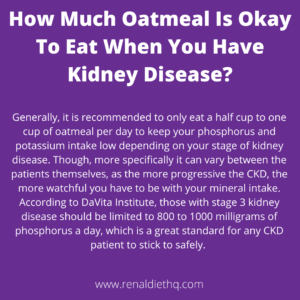 Generally, it is recommended to only eat a half cup to one cup of oatmeal per day to keep your phosphorus and potassium intake low depending on your stage of kidney disease. Though, more specifically it can vary between the patients themselves, as the more progressive the CKD, the more watchful you have to be with your mineral intake. According to DaVita Institute, those with stage 3 kidney disease should be limited to 800 to 1000 milligrams of phosphorus a day, which is a great standard for any CKD patient to stick to safely.
Generally, it is recommended to only eat a half cup to one cup of oatmeal per day to keep your phosphorus and potassium intake low depending on your stage of kidney disease. Though, more specifically it can vary between the patients themselves, as the more progressive the CKD, the more watchful you have to be with your mineral intake. According to DaVita Institute, those with stage 3 kidney disease should be limited to 800 to 1000 milligrams of phosphorus a day, which is a great standard for any CKD patient to stick to safely.
Are There Healthier Choices Than Oatmeal for CKD Patients?
Oatmeal is a healthy choice for its fiber and mineral content, but its levels of phosphorus and potassium may leave some CKD patients worried about eating it. The good news is there are plenty of cereal options that can replace oatmeal that may even be more delicious and provide health benefits.
Reasons To Not Eat Oatmeal on a Renal Diet
High phosphorus levelsHigh potassium levelsProcessed oatmeal has added sodiumIntake should be closely monitored
What Cereal Can Kidney Patients Eat Besides Oatmeal?
Corn Pops
Corn Pops are a delicious cold cereal alternative to oatmeal that doesnât contain a lot of added sugars, and only has 30 milligrams of potassium, 160 of sodium, and has no listed phosphorus! It is also affordable and available widely in grocery stores.
Frosted Mini Wheats
If you want an alternative to oatmeal that will still have a ton of flavor and fiber, then Frosted Mini Wheats will be a perfect option for you! While this option does include 10% phosphorus, it has much less sodium at only 10 milligrams per serving, and contains 160 milligrams of potassium. You can decrease the potassium and sugars by purchasing their unfrosted version of this cereal as well.
Cream of Rice
A great hot cereal alternative to oatmeal is Cream of Rice. It is gluten-free, cholesterol-free, and while it does include ferric orthophosphate as an iron added, there are no other phosphates listed. The potassium content is only 30mg, and contains zero sodium!
Can I Eat Oatmeal Cookies on a Renal Diet?
Since oatmeal can still be eaten on a renal diet, in moderation, you can definitely eat oatmeal cookies. Just be sure you are taking into account any additional potassium, phosphorus, and sugars that are being added to make the cookie dough. Here is a great kidney-approved recipe for oatmeal breakfast cookies.
You can eat oatmeal on a renal diet, but you need to be careful how much you eat.
Oatmeal and kidney disease may not be a perfect match, but if you are following a renal diet and keeping track of your intake of phosphorus and potassium, then you can absolutely enjoy oatmeal in all of its forms as long as you do so responsibly and if needed contact health professionals. If you are looking for an alternative to this popular hot cereal, try some of the cold or hot cereal alternatives listed in this post!
The post Oatmeal & Your Renal Diet: What You Need To Know appeared first on Renal Diet Menu Headquarters.
Suggested Reading:
Cereals Low in Potassium and Phosphorus Low Potassium Hot & Cold Breakfast Cereals for CKD Patients Everything You Need To Know About Plant Based Milks For Pre-Dialysis (CKD Diet)June 13, 2022
Pumpkin Spice Meringue Cookies (Low-Sugar!)
 Whether itâs the beginning of the crisp Fall season, or you are just looking for a delicious and fun cookie flavor for any season, or day of the week, pumpkin spice will answer all your cravings! These meringue cookies are a wonderful blend of pumpkin, cinnamon, nutmeg, and best of all, they are low on sugar!
Whether itâs the beginning of the crisp Fall season, or you are just looking for a delicious and fun cookie flavor for any season, or day of the week, pumpkin spice will answer all your cravings! These meringue cookies are a wonderful blend of pumpkin, cinnamon, nutmeg, and best of all, they are low on sugar!
These pumpkin spice meringue cookies are fun, easy, and have a deep cinnamon and fresh pumpkin flavor. They are light and chewy on the inside and crunchy on the outside, the best of both worlds for textures! So, keep reading to find out how to make these renal-friendly confections, and why they are a good choice for baked treats for those sticking to a renal or a diabetic diet.
What Are Meringue Cookies?
If you have never heard of a meringue or eaten one and you were to see a picture, you would probably imagine they have a marshmallow-like consistency. While both are delicious, that is actually not at all what a meringueâs texture is like.
This perfect, delicate meringue is chewy on the inside and crunchy on the outside. This simple dessert is usually made with very few ingredients, the main ones being egg whites, an acid like vinegar or cream of tartar, and sugar, which are whipped together to get that pillowy look that we want!
These sweet treats are a popular dessert associated with European countries such as Switzerland and France. In this version, these pumpkin spice meringue cookies will have all of the additional flavors that we love around fall time, pumpkin pie spice.
Do Meringue Cookies Taste Good With Pumpkin Spice?
If you are a fan of pumpkin spice, you likely know that it is a flavor that goes with anything, and these meringue cookies are no exception! Pumpkin spice is a delicious, and every popular, flavor used in many coffee syrups, creamers, and various baked goods.
Since the meringue is a part of the baked good family, pumpkin spice and this traditional French treat will pair beautifully. If you are not familiar with pumpkin spice, it has a flavor similar to pumpkin pie in that it consists of the earthy sweetness that comes from the pumpkin and the various fall time spices we love, such as cinnamon, nutmeg, allspice, and cloves!
Can I Eat Pumpkin Spice Meringue On a Renal Diet?
As many of you who are cooking for, or are on a renal diet yourselves know, pumpkin can be a high potassium vegetable. However, there are many ways to make the pumpkin spice flavor without the worry of high potassium or high sodium. One way is to buy it from the store. Walmart has an affordable premade pumpkin spice blend that you can find here.
You can also make your own spice blend with freshly ground cinnamon, cloves, and nutmeg to add to your meringue mixture! You can omit the use of canned or fresh pumpkin puree if you want to, or you can include a modest ½ cup of canned or fresh pumpkin. Just keep in mind that this will add a significant portion of your potassium into this cookie.
Reasons Pumpkin Meringue Cookies Are Okay for Kidney Disease Patients
These Pumpkin spice meringue cookies are great for those on a renal-friendly diet because they are low in sugar, sodium, and potassium!
While the most potassium-rich part is the optional use of pumpkin puree itself. The other ingredients are simple herbs and spices, that can be found fresh or in-store without added sodium and sugars.
Ingredients You Need for Low Sugar Pumpkin Meringues
3 large egg whites
½ teaspoon cream of tartar
â cup Splenda or other sugar substitute
2 teaspoons vanilla extract
Pinch of pumpkin pie spice
How To Make Pumpkin Spice Meringue Cookies1. Preheat oven to 200 degrees Fahrenheit (or 180 degrees Celsius)
2. Combine all dry ingredients in a bowl
3. Beat eggs until frothy
4. Add Splenda and continue beating until stiff peaks form
5. Fold in pumpkin puree and vanilla
6. Drop by tablespoonfuls onto parchment paper lined baking sheet
7. Bake at 200 degrees F (180 degrees C) for about 15 minutes
8. Remove from oven and allow to cool completely before serving
How Do You Know When Meringue Cookies Are Done? The best way to know when your meringue cookies are done is to make sure they are dry all the way through. This means that you should take one out towards the end of the baking time, cut it in half, and check to make sure the inside has cooked fully and the cookie is dry all the way through.
The best way to know when your meringue cookies are done is to make sure they are dry all the way through. This means that you should take one out towards the end of the baking time, cut it in half, and check to make sure the inside has cooked fully and the cookie is dry all the way through.
Are Pumpkin Meringues Cookies Chewy?
Pumpkin meringues can be chewy, or they can be crispy throughout, depending on the baking method you use! You can cook them longer on a slightly lower heat to get them fully crispy, or you can cook them at their normal baking temp for a slightly shorter time and check for a chewy but dry center when they are done.
How To Store Pumpkin Spice Meringue Cookies
If you have successfully baked these amazing pumpkin spice meringues then they will last for up to 2 weeks in an airtight container at room temperature, if you store them in the fridge, they can become soft and sticky due to condensation. If you have uncooked batter you wish to use, it can be refrigerated but should be used within 24 hours of making it, as it contains those egg whites.
Can I Freeze Meringue Cookies?
Yes, you can freeze meringue cookies! The baked cookies will keep for up to 2 to 3 months if placed in an airtight container in your freezer. They will just need to be thawed to room temperature, and they will be ready to eat again, though their texture may change slightly and become chewier.
Pumpkin spice meringue cookies are a delicious treat and snack, especially for those eating a renal diet.
If you are looking for a sweet treat that you can enjoy on a renal diet, then these pumpkin desserts are perfect for you. Filled with many flavors that remind us of the holidays or the cooler months, these cookies are easy and, best of all, a healthy alternative to store-bought cookies! These homemade meringue cookies have low sugar, virtually no sodium, and are low in potassium content, making them safe to eat for those with kidney disease.
The post Pumpkin Spice Meringue Cookies (Low-Sugar!) appeared first on Renal Diet Menu Headquarters.
Suggested Reading:
RDHQ 89 Flavis Desserts for Kidney Disease Patients Scrumptious, Kidney Friendly Desserts! Renal Diet Approved! Low Sodium and Potassium Substitutions For Your Holiday FavoritesJune 7, 2022
Cereals Low in Potassium and Phosphorus
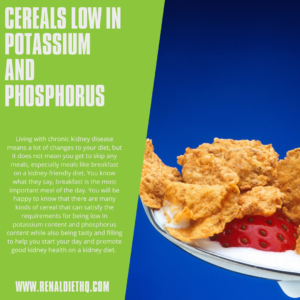 Living with chronic kidney disease means a lot of changes to your diet, but it does not mean you get to skip any meals, especially meals like breakfast on a kidney-friendly diet. You know what they say, breakfast is the most important meal of the day. You will be happy to know that there are many kinds of cereal that can satisfy the requirements for being low in potassium content and phosphorus content while also being tasty and filling to help you start your day and promote good kidney health on a kidney diet.
Living with chronic kidney disease means a lot of changes to your diet, but it does not mean you get to skip any meals, especially meals like breakfast on a kidney-friendly diet. You know what they say, breakfast is the most important meal of the day. You will be happy to know that there are many kinds of cereal that can satisfy the requirements for being low in potassium content and phosphorus content while also being tasty and filling to help you start your day and promote good kidney health on a kidney diet.
Why Do Kidney Patients Need To Eat Low Potassium and Phosphorus Foods?
Chronic kidney disease patients need to eat low potassium and phosphorus foods because the damaged kidneys cannot clean out the excess of these minerals as well as they could before. The inability to get rid of the excess of these minerals leads to a buildup of potassium and phosphorus in the body which can lead to a multitude of health risks. An increase in phosphorus in the body can lead to brittle bones, itchy skin, and other skin problems. An increased amount of potassium in the body can lead to fatigue, nausea, muscle pain, breathing issues, and heart issues.
Are There Cereals That Have Low Potassium and Phosphorus?
You may think that it would be hard to find low potassium and phosphorus cereals, but there are actually many different options for cereals that meet these requirements. There are many that are even popular brands that you may enjoy now without even knowing! Keep reading to learn all of the delicious and healthy cereal options for you if you are looking for breakfast options with a great ingredient list for CKD patients that also have great health benefits.
Breakfast Cereals Low In Potassium & Phosphorus for CKD Patients
Corn Pops
A Kellog brand cereal which you surely see every trip you take down the cereal aisle at your local grocery store, Corn Pops are actually an option that is low in sodium, potassium, and phosphorus intake. This is a tasty and simple sweet corn cereal, and it only has 30 milligrams of potassium, 160 milligrams of sodium, and no listed phosphorus. This is a great option for those who do not want any fruity flavors but still enjoy a sweeter cereal.
Frosted Mini-Wheats
Frosted Mini-Wheats are the most popular form of shredded wheat cereal and they are packed with healthy fiber as well as being lower in potassium, sodium, and phosphorus. While not as low in potassium as our previous choice, these still have a low amount at about 160 milligrams of potassium in the entire 32-ounce box. There are 10 milligrams of sodium and about 10 percent phosphorus.
Fruit Loops
Fruit Loops are a classic fruity cereal option that may remind you of childhood, but if these are the types of breakfast flavors you enjoy, you will be happy to know that this is a low potassium and low phosphorus option you can enjoy on a CKD diet. While this option does have a higher amount of sodium with 180 milligrams per box, it does have the benefit of having no phosphorus, and having only 60 milligrams of potassium.
Apple Jacks
Apples may be a great fruit for those on CKD diets, but the tasty cinnamon-apple cereal, Apple Jacks, is also safe to eat if you have chronic kidney disease. This is an interesting combination of slightly fruity apple and cinnamon flavors. This unique cereal can be enjoyed guilt-free because it is low in potassium and phosphorus. It is not as low as other options for sodium as it has 210 milligrams, but it does not have any phosphorus. In addition to these pros, it only has 50 milligrams of potassium.
Which Hot Cereals Are Low Potassium and Low Phosphorus?
Bobâs Red Mill Creamy Wheat
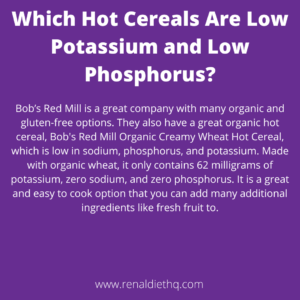 Bobâs Red Mill is a great company with many organic and gluten-free options. They also have a great organic hot cereal, Bob's Red Mill Organic Creamy Wheat Hot Cereal, which is low in sodium, phosphorus, and potassium. Made with organic wheat, it only contains 62 milligrams of potassium, zero sodium, and zero phosphorus. It is a great and easy to cook option that you can add many additional ingredients like fresh fruit to.
Bobâs Red Mill is a great company with many organic and gluten-free options. They also have a great organic hot cereal, Bob's Red Mill Organic Creamy Wheat Hot Cereal, which is low in sodium, phosphorus, and potassium. Made with organic wheat, it only contains 62 milligrams of potassium, zero sodium, and zero phosphorus. It is a great and easy to cook option that you can add many additional ingredients like fresh fruit to.
Cream of Wheat
If you are looking for hot cereals low in potassium and phosphorus, then Cream of Wheat will fit your exact needs. Certified Kosher and fat free, this option is also made with wheat but does contain more sodium than our previous option. At about 100 milligrams of sodium, it isnât too crazy and it only has 30 milligrams of potassium. Phosphorus is not included. A quick and affordable option that is readily available at many local grocery stores, this is a great attainable hot cereal that you can enjoy with CKD.
Cream of Rice
Much like the last option, there is a brand and product called Cream of Rice. It is a hot cereal that is gluten-free, fat-free, Kosher-certified, cholesterol-free, and a great addition to a healthy diet. It is also low in potassium and phosphorus. It contains zero sodium, zero phosphorus, and only 30 milligrams of potassium.
The Best Low Potassium Granola Recipes For a Renal Diet
Natureâs Path
Natureâs Path has a honey almond flavor that is low in potassium, sodium, and phosphorus. It is made with gluten-free oats, honey, and almonds. It is a simple and tasty option for those who need gluten-free options as well as those on a renal diet. It has about 90 milligrams of potassium, 65 milligrams of sodium, and no listed phosphorus.
KIND granola
KIND is a popular brand that makes various forms of healthy grain bars, cereals, and granola clusters. KIND Healthy Grains Oats & Honey Clusters with Toasted Coconut is a low potassium granola option. It's gluten-free, Kosher, and has no GMOs. It only contains 75 milligrams of potassium, 25 milligrams of sodium, and no phosphorus.
Thrive Market Granola
Thrive Market has a delicious and healthy granola option that is grain-free. Organic Granola, Vanilla Cinna-Yum has a few more flavors than our other options and is low potassium, low phosphorus, low sodium, gluten-free, vegan, and dairy-free. It has only 55 milligrams of sodium, about 70 milligrams of potassium, and no phosphorus.
Breakfast for CKD patients can be tricky, but luckily there are quite a few choices for eating low potassium and low phosphorus cereals.
Breakfast is the most important meal of the day, and these options of cereal for kidney disease should make you feel confident that you can keep enjoying some of your favorite cold and hot cereals low in amounts of potassium and phosphorus levels. Always consult with your health professional to acquire a deeper understanding about health and how to read cereal labels. Whether you want something fruity, natural, gluten-free, hot, or cold, you have many options and are not as limited as you may think when it comes to tasty and quick breakfast choices.
The post Cereals Low in Potassium and Phosphorus appeared first on Renal Diet Menu Headquarters.
Suggested Reading:
Low Potassium Hot & Cold Breakfast Cereals for CKD Patients Renal Diet Breakfast: Overnight Cream of Wheat With Rice Milk Everything You Need To Know About Plant Based Milks For Pre-Dialysis (CKD Diet)May 31, 2022
How to Season & Flavor Your Food Without Salt
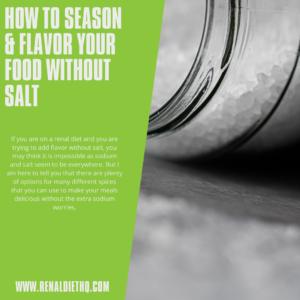 If you are on a renal diet and you are trying to add flavor without salt, you may think it is impossible as sodium and salt seem to be everywhere. But I am here to tell you that there are plenty of options for many different spices that you can use to make your meals delicious without the extra sodium worries.
If you are on a renal diet and you are trying to add flavor without salt, you may think it is impossible as sodium and salt seem to be everywhere. But I am here to tell you that there are plenty of options for many different spices that you can use to make your meals delicious without the extra sodium worries.
Can You Make Food Taste Salty Without Salt?
What Is The Healthiest Substitute for Salt?
The healthiest substitutes to season food without excess salt comes from fresh herbs, garlic, onion, and vinegar. Fresh herbs are healthy because they are fresh and untouched by preservatives and other additives. Fresh garlic is also a wonderful and healthy alternative that is widely popular as a seasoning for savory flavor already. Onion and vinegar can add great flavors. All in all, if you are looking for a standout healthiest alternative, garlic would be the number one. Garlic has many health benefits, such as lowering blood pressure, lowering cholesterol, and has powerful antioxidants. It is an all-around great addition to your meals.
Is MSG a Good Salt Substitute?
While MSG is not a complete sodium replacement, it may be good to use for those on low sodium diets, like those with chronic kidney disease. MSG stands for monosodium glutamate, and glutamate is already present in some levels in your food and in your body. Many studies have shown that by using MSG as a replacement for table salt, people showed a decrease in overall sodium in their diets. So, while it is not the healthiest replacement, it does add flavor while reducing the sodium intake in comparison with those who use table salt to season.
How To Add Flavor or Seasoning To Your Food Without Salt
Cumin
Cumin may not be a major player when most people think of seasonings, but it is used for many things. Popular in taco and grill seasonings, this spice is earthy, has slight notes of citrus, and pairs well with spices such as peppers and red pepper flakes. It can be very versatile and makes wonderful grilled meat and vegetable seasoning.
Dill
Dill is probably the most popular for its role in pickling and the flavors which come from pickles. In its herb form, dill is fresh, slightly sweet, and has a bit of an earthy or grassy smell and flavor to it. It is most notably used in light Mediterranean dishes, cold soups, seafood, along with things like pickles.
Garlic
As I mentioned above, garlic is one of the healthiest and most popular types of seasonings out there. It is used in nearly every meal and has plenty of positive qualities for your health, from anti-inflammatory abilities, antioxidants, lowering blood pressure, and lowering cholesterol. This seasoning component produces a bit of a nutty and mustard-like flavor when cooked and added to dishes. Popular in pastas, breads, and a variety of meat and seafood dishes, this is a no-brainer to have around your house to add flavor without salt.
Basil
Basil is an interesting herb that is related to the mint family. As such, its flavors are quite a mix of strange yet delicious notes ranging from sweet, minty, licorice-like, and slightly citrus. There are many different types of Basil, all with different flavors and purposes, but the most popular you are likely to find is the sweet basil variation. Basil is a great way to add a fresh and slightly sweet element to things like tomato soup, Caprese salad, Asian and Indian foods, and chicken dishes.
How To Make Food Taste Salty Without Salt
Add Lemon Juice or Citrus
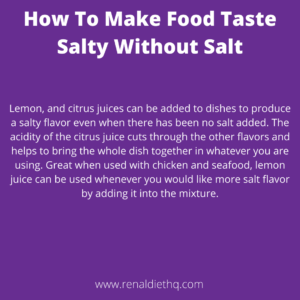 Lemon, and citrus juices can be added to dishes to produce a salty flavor even when there has been no salt added. The acidity of the citrus juice cuts through the other flavors and helps to bring the whole dish together in whatever you are using. Great when used with chicken and seafood, lemon juice can be used whenever you would like more salt flavor by adding it into the mixture.
Lemon, and citrus juices can be added to dishes to produce a salty flavor even when there has been no salt added. The acidity of the citrus juice cuts through the other flavors and helps to bring the whole dish together in whatever you are using. Great when used with chicken and seafood, lemon juice can be used whenever you would like more salt flavor by adding it into the mixture.
Add Vinegar
There are many different kinds of vinegar, and they each can add a different level of flavor and saltiness to the dish you are creating. Red wine vinegar can brighten up the flavors of a red meat dish like steak or mushrooms risotto. Apple cider vinegar can be used to add a light tart flavor to chicken, some desserts, and other dishes that call for a subtle sweetness. White wine vinegar can be used in nearly any dish as it is light enough to add saltiness and brighten up any rich flavors that may be present also.
Tart Fruits
Just as the tartness of vinegar can bring out the saltiness and other flavors present in your dishes, so too can fruits! It may seem odd to think of fruits as a way to make food taste salty without salt, but things like pomegranates, raspberries, and even cranberries can be great ways to add salty flavors and additional flavors you will love to your favorite dishes. The acidity of these tart fruits helps to produce their salty taste, but the other elements like sweetness and tanginess add depth to the dishes, especially with things like chicken, stews, savory dishes, and of course, sweet dishes too.
Cooking Without Salt Tips
The most important tip when cooking without salt is to be watchful of your ingredients. You want to make sure the ingredients you are starting with donât already have high sodium levels. This means you should buy a lot of fresh ingredients and definitely avoid pre-seasoned items unless you know salt was not used.
You donât want to start out with additional sodium levels that you do not need. A few more tips are to understand the flavors you want to bring out in the dish, we all use salt but do we know why? It brings out the flavors and can cut through a lot of bitterness in dishes, but so can many other seasoning options.
So, be sure you actually understand your seasoning options and what you can get out of them. A light dish can be made fragrant and fresh with dill. Chicken can be made more earthy and nutty with cooked garlic, and red wine vinegar is a wonderful way to bring out the best flavors in sautéed mushrooms. Garlic should always be cooked to bring out the maximum flavor and to dull down its pungent odor.
The final tip I have for cooking without salt is to experiment with different things and taste as you go! There is nothing worse than thinking you are adding all the right things, but then the dish is done, and it tastes a little off. So, while you are learning what flavors and herbs to add, be sure to taste as you add to know the effects of each seasoning.
Knowing how to season and flavor your food without salt is a healthy option and will help make your salt-free meals tastier.
If you are feeling lost at the prospect of seasoning your meals without salt, then donât worry! This actually opens you up to a whole world of seasonings which are so much better for you health wise. There are plenty of creative ways to add salty flavors without adding sodium into your diet, from interesting things like pomegranates to more notable herbs such as garlic.
The post How to Season & Flavor Your Food Without Salt appeared first on Renal Diet Menu Headquarters.
Suggested Reading:
RDHQ Podcast 94: Condiments Do’s and Don’ts RDHQ Podcast 99: Herbs and Spices – The Renal Diet Secret Weapon For Delicious Food RDHQ Podcast 104: Why You Need To Stop Using The Lists Of Foods The Nurse Gave You (Do This Instead)May 24, 2022
CKD Diet: Low Potassium Smoothies
[image error]Cooking on a chronic kidney disease diet can seem stressful and quite a chore. Sometimes we just want something simple that still fills us up or gives us a healthy snack. Thatâs where delicious, fresh, and a healthy smoothie can come in. Smoothies are an easy way to enjoy a snack with quality protein or a breakfast or lunch option on a kidney diet. You can pack a homemade smoothie with many kidney-friendly smoothie options and ingredients and nutrients that are good for you and will give you the energy to get through the day.
Are Smoothies Good for Kidneys?
Smoothies can include many kidney-friendly ingredients that are good for your overall health and a healthy diet. However, it is important to remember that smoothies are a good majority liquid and may not be the best option for substitutes for those on dialysis, as the liquid intake would have to be monitored heavily.
What Kinds of Smoothies Are Good for Kidneys?
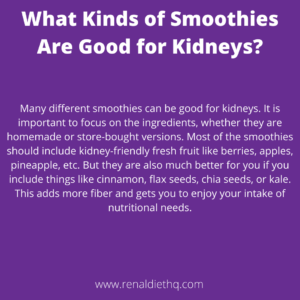 Many different smoothies can be good for kidneys. It is important to focus on the ingredients, whether they are homemade or store-bought versions. Most of the smoothies should include kidney-friendly fresh fruit like berries, apples, pineapple, etc. But they are also much better for you if you include things like cinnamon, flax seeds, chia seeds, or kale. This adds more fiber and gets you to enjoy your intake of nutritional needs.
Many different smoothies can be good for kidneys. It is important to focus on the ingredients, whether they are homemade or store-bought versions. Most of the smoothies should include kidney-friendly fresh fruit like berries, apples, pineapple, etc. But they are also much better for you if you include things like cinnamon, flax seeds, chia seeds, or kale. This adds more fiber and gets you to enjoy your intake of nutritional needs.
High Protein & Low Potassium Smoothie Recipes
Cinnamon Apple Tofu
This may sound a little strange if you are not used to using tofu in many dishes, but tofu is a great ingredient that adds protein to just about anything. It also has the ability to be flavored and blend into whatever spice or ingredients you are pairing it with. This high protein, low potassium smoothie recipe can be created by using this chronic kidney disease friendly recipe, as a base. You should include apples, cinnamon, tofu, dairy-free milk, oats, and any other additions you may want to add. You can sweeten it with honey or maple syrup and have a delicious dessert like a smoothie that is packed with protein.
Peach Protein
This high protein low potassium fruit smoothie recipe is a great one for those really looking for maximum flavor and maximum protein. The Peach High-Protein Fruit Smoothie just calls for powdered egg whites, ice, peaches, and sugar. A very simple smoothie that is delicious and helps you meet your protein goals for the day.
The Best Low Potassium Fruits for Smoothies
Blueberries
These little berries are great for kidney-friendly smoothies because they include antioxidants, are low in sodium, and low in phosphorus. They are less than 150 milligrams of potassium, as well, making them even more kidney-friendly. High in fiber and low in calories, these fresh or frozen blueberries really pack a healthy punch.
Peaches
Peaches are a good addition to low potassium smoothies because they are one of the sweeter, low potassium fruits. They are a better alternative to the common mango which is included in many recipes but is higher in potassium. Peaches are very easy to pair flavors with as they can be sweet, tangy, and tart depending on their ripeness and what flavors you add with them in your smoothies.
Pineapple
If you are on a renal diet and are looking for a good ingredient for your low potassium smoothie recipe, you will be happy to know that pineapples have the lowest potassium of many of the tropical fruits we love. Kiwi and other citrus fruits can contain high potassium, so pineapple will help you achieve that tropical flavor while still being safe on your renal diet.
Cranberries
Many of us know that cranberries are good for things like urinary tract infections and other bladder issues, but are they good for your kidneys as well? The answer is yes! Since the phytonutrients inside the cranberries are what helps to prevent bacteria from building up and causing urinary tract infections, and UTIs and kidney disease frequently go hand in hand, they are very helpful at inhibiting the buildup of those bacteria.
Apples
Apples may not be your first choice when you think of smoothie ingredients, but they are a fruit that has tons of variety, and is low in potassium, sodium, and phosphorus. A very versatile fruit, the apple can be sweet or tart and can help bring a bright flavor to your smoothies. It pairs great with cinnamon, kale, and light fruits like pineapple or peaches.
Which Fruits Have High Potassium?
Avocado
Many healthy dishes and smoothies love to include avocado. While it is a fruit with a great source of healthy fats and proteins, it is also one of the fruits with the highest level of potassium. For one average avocado, there is about 975 milligrams of potassium.
Banana
Bananas are famously a potassium-rich fruit, which means they are not a great option for those looking for a low potassium smoothie. While they have less than the avocado, with about 422 milligrams of potassium in the average banana, it should still be avoided or enjoyed in moderation.
Kiwi
Like many of our tropical fruits, the kiwi is high in potassium and should be avoided. It is also high in oxalate, which can be a concern for those with urinary or kidney stones as it could make that condition worse.
Citrus Fruits
Not all citrus fruits, but some, are high in potassium and should be avoided when you are gathering low potassium smoothie ingredients. Grapefruit, apricots, and oranges are all high in potassium.
Do Premade Smoothies Have Low Potassium?
NovaSource Renal
NovaSource Renal has an entire brand centered around renal safe products and they have many options for low potassium smoothies such as their peaches and cream shake, lime coconut cooler, and their apple cinnamon shake. Explore their recipes here.
Nepro
Nepro focuses mainly on shakes that are safe and healthy supplements for those with chronic kidney disease, but they also have a mixed berry flavor. This flavor can be enjoyed by itself or added to a berry-based smoothie recipe without adding any additional liquid. It is made with carb steady ingredients, so it is a good choice for those with diabetes as well as those on dialysis.
Frozen Fruit Packs
Dole has a few frozen fruit smoothie packs which are great for low potassium smoothie recipes. This one, Veggie Berries ân Kale, is especially great for those on a renal diet and includes many of our good kidney ingredients. The pack only has 240 milligrams of potassium in total and is an easy way to start your favorite smoothie without plucking and chopping your ingredients.
Eating low potassium smoothies on a CKD diet makes a delicious and healthy breakfast or lunch.
Smoothies can be a delicious substitute to avoid cooking or when you are in a rush, and with these low potassium smoothie options, you can be sure that you are using healthy and kidney-friendly foods and ingredients as additions to smoothies to make your favorite snack.
The post CKD Diet: Low Potassium Smoothies appeared first on Renal Diet Menu Headquarters.
Suggested Reading:
Make A Healthy Smoothie For Kidney Failure Meals Instead! Starfruit & Kidney Disease: Why They Donât Mix! Low Sodium and Potassium Substitutions For Your Holiday FavoritesMay 17, 2022
Renal Diet: Diabetic Sample Menu Ideas
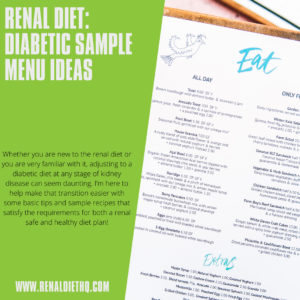 Whether you are new to the renal diet or you are very familiar with it, adjusting to a diabetic diet at any stage of kidney disease can seem daunting. Iâm here to help make that transition easier with some basic tips and sample recipes that satisfy the requirements for both a renal safe and healthy diet plan!
Whether you are new to the renal diet or you are very familiar with it, adjusting to a diabetic diet at any stage of kidney disease can seem daunting. Iâm here to help make that transition easier with some basic tips and sample recipes that satisfy the requirements for both a renal safe and healthy diet plan!
What Is a Renal Diabetic Diet?
A renal diabetic diet is a diet that takes the nutritional, general dietary, and other restrictions of the renal diet and the diabetic diet and puts them into one. So, essentially, this type of diet is the perfect thing for those who are diabetic and people with kidney disease. This type of kidney diet will take into account low carbs, low sugar, low sodium, low potassium, and other restrictions and adjustments that are characteristic of both diets.
Who Needs To Eat a Renal Diabetic Diet?
Anyone can use this diet and these diet plan samples if they want to, but those who benefit the most from it are individuals who have diabetes and who deal with chronic kidney disease. While this is not a dialysis-specific diet, many of the recipe examples and the diet itself could still be beneficial to show recipes for dialysis patients with diabetes, with a few adjustments and watchfulness of liquid intake.
Renal Diabetic Diet Menu Ideas
When formatting your renal diabetic diet, it is important to speak with your physician and your dietician in order to make sure you cover all of your needed restrictions for your current condition and to find a daily routine. Some of the basics for a diabetic diet are to stick to vegetables and lean proteins that are heart healthy. Youâll want to include foods with a good source of fiber and healthy fats. For a renal diet, the most common types of food to include are low sodium, low potassium, low phosphorus, and low calcium foods.
The renal diet is more focused on the mineral and nutritional content in the foods themselves rather than specific subsections of foods, which can make it difficult to find things that work for you. However, it is also a good thing because it allows you to easily find options that will cover both the diabetic and renal diet requirements.
Things You Canât Eat On a Renal Diabetic Diet
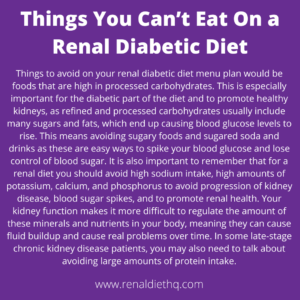 Things to avoid on your renal diabetic diet menu plan would be foods that are high in processed carbohydrates. This is especially important for the diabetic part of the diet and to promote healthy kidneys, as refined and processed carbohydrates usually include many sugars and fats, which end up causing blood glucose levels to rise. This means avoiding sugary foods and sugared soda and drinks as these are easy ways to spike your blood glucose and lose control of blood sugar. It is also important to remember that for a renal diet you should avoid high sodium intake, high amounts of potassium, calcium, and phosphorus to avoid progression of kidney disease, blood sugar spikes, and to promote renal health. Your kidney function makes it more difficult to regulate the amount of these minerals and nutrients in your body, meaning they can cause fluid buildup and cause real problems over time. In some late-stage chronic kidney disease patients, you may also need to talk about avoiding large amounts of protein intake.
Things to avoid on your renal diabetic diet menu plan would be foods that are high in processed carbohydrates. This is especially important for the diabetic part of the diet and to promote healthy kidneys, as refined and processed carbohydrates usually include many sugars and fats, which end up causing blood glucose levels to rise. This means avoiding sugary foods and sugared soda and drinks as these are easy ways to spike your blood glucose and lose control of blood sugar. It is also important to remember that for a renal diet you should avoid high sodium intake, high amounts of potassium, calcium, and phosphorus to avoid progression of kidney disease, blood sugar spikes, and to promote renal health. Your kidney function makes it more difficult to regulate the amount of these minerals and nutrients in your body, meaning they can cause fluid buildup and cause real problems over time. In some late-stage chronic kidney disease patients, you may also need to talk about avoiding large amounts of protein intake.
Sample Renal Diabetic Diet Menu PlansBreakfast
A nice way to start off your day is with this Arugula Portobello and Feta Frittata Vegetarian Breakfast renal diabetic diet menu plan recipe for good kidney health. It includes all the good things you want in a breakfast and keeps in mind the restrictions of both diets. It contains very few carbs and complex carbs and is made with eggs, vegetables, and cheese!
Other similar options can be found here. A good thing to remember is that eggs are a great source of protein without the negative effects of red meats.
Lunch
Lunch may be a time some of us forget but it is an essential part of our day. One way to enjoy your lunch while sticking to a renal diabetic diet menu plan is to use this Vegetarian Sloppy Joe Wrap recipe. Low in carbs because we replace the tortilla with lettuce, it is perfect for a diabetic diet. It also includes various vegetables and a protein of your choice; ground beef works well. The spices used are salt-free, gluten-free, and have no GMOs.
Dinner
Good dinner options and healthy meals for renal diabetic menu plans and kidney patients usually consist of lean protein, vegetables, and possibly some other source of low carbohydrate content or fiber. A good example for your plan is this Herbed Chicken and Veggies recipe. This recipe is low in carbs and uses spices that are salt-free, gluten-free, and have zero GMOs. You can use many variations of this style of dinner option and make it with other lean proteins such as fish, which are a great source of healthy fats.
Snacks
Snack foods are an important aspect of our day and can help to create better eating habits throughout the day. A few simple snack ideas include fruit, and can be found here. While an excess of fruit is not ideal for diabetics because of their natural sugars, it is a better option than those processed chips or ice cream bars. Grilled peaches are a wonderful and easy snack to prepare, and frozen fruit can give you that same cold treat sensation, without the additional sugars and dairy. A few more options of snack foods include grilled vegetables like Parmesan Zucchini Logs. These delicious foods are low in carbs, super tasty, and include lean protein in the form of turkey bacon.
Renal Diet Menu Plan PDF
If you would like more ideas like these to complete full weeks of meal planning then download this Renal Diabetic Diet Menu Plan PDF.
Recipes For Dialysis Patients With Diabetes
Low Sodium Stuffed Spaghetti Squash
As I mentioned previously, some of these recipes can be used for those on dialysis as well. One of these recipes is the Low Sodium Stuffed Spaghetti Squash. This recipe is great for diabetics because it uses shredded spaghetti squash rather than rice which can be high in processed carbs depending on the kind. The rest of the ingredients include vegetables and proteins like ground beef. The seasonings on all of these are kidney safe and even safe for those on dialysis as they are only 15 mg of sodium per packet on the nutrition label.
Top Renal Diabetic Diet Grocery List ItemsFor proteins, if you are shopping for a renal diabetic diet menu plan, your best options are: turkey, chicken, and fish. You can occasionally include ground beef, but it is best to stick to lean and healthy meats.For snacks and additions to your other dishes, you want to look for fruits like berries, peaches, grapes, and apples. You can also include no sodium nuts or seeds.Vegetables like zucchini, cauliflower, garlic, bell peppers, and cabbage. There are many more you can include but you just have to make sure they are low in phosphorus, potassium, and sodium.Use these renal diabetic diet sample menus to help make eating this kind of diet as a dialysis patient with diabetes a little bit easier.
If you are transitioning to a diabetic version of the renal diet menu plan, or you are trying to start out with both, then these recipes are perfect for you to start with. These simple, delicious recipes can help you build a meal plan that works for you.
The post Renal Diet: Diabetic Sample Menu Ideas appeared first on Renal Diet Menu Headquarters.
Suggested Reading:
Low Sodium and Potassium Substitutions For Your Holiday Favorites I Need A Low Cholesterol, Diabetic, And Pre-Dialysis Diet – Help! Healthy, Renal-Friendly Diet Snack Ideas Perfect For CKDMay 10, 2022
Starfruit & Kidney Disease: Why They Donât Mix!
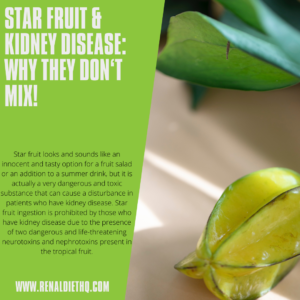 Star fruit looks and sounds like an innocent and tasty option for a fruit salad or an addition to a summer drink, but it is actually a very dangerous and toxic substance that can cause a disturbance in patients who have kidney disease. Star fruit ingestion is prohibited by those who have kidney disease due to the presence of two dangerous and life-threatening neurotoxins and nephrotoxins present in the tropical fruit.
Star fruit looks and sounds like an innocent and tasty option for a fruit salad or an addition to a summer drink, but it is actually a very dangerous and toxic substance that can cause a disturbance in patients who have kidney disease. Star fruit ingestion is prohibited by those who have kidney disease due to the presence of two dangerous and life-threatening neurotoxins and nephrotoxins present in the tropical fruit.
Star fruit is a bright and interesting fruit that is native to tropical regions of Southeast Asia and Brazil. It has an edible skin and, when cut into slices, resembles a five-pointed star. It is sweet, sour, and has a somewhat citrus-like flavor. They come in yellow or green colors, and are sweeter in their larger variety, with smaller versions of the fruit retaining a sour taste, much like a lemon. While it has gained popularity all over the world for its fun shape and uses, regardless of the type of star fruit, the effects of star fruit can be life-threatening to those with damaged kidneys or those who have trouble filtering out toxins.
Is Star Fruit Bad For Kidneys?Ingestion of star fruit may not be that bad for the kidneys when eaten by the generally healthy population, though it must still be consumed in moderation, it is detrimental to those with kidney disease or any current kidney damage. Star fruit contains toxins oxalic acid and caramboxin acid, which can have a fatal outcome if accumulated in the blood of renal patients. The star fruit does not cause damage to the kidneys themselves in those without kidney damage. However, the damage it causes comes from the fact that the already damaged kidneys cannot filter out the toxins present in the fruit as they are consumed.
Normally the fruit causes no issues, but if the toxins are not filtered out and accumulate in the blood, they can travel to the brain or the kidneys and further damage them or have lethal and toxic effects on people with kidney disease or renal insufficiency. Always consult a healthcare professional first to prevent any star fruit intoxication, star fruit nephrotoxicity, or star fruit-induced acute renal failure. The effects of the toxin result in neurotoxicity and nephrotoxicity, the rapid deterioration of the brain and kidneys due to the presence of a toxin or damaging chemical substance.
Should I Eat Star Fruit if I am on Dialysis?If you are on dialysis, star fruit should not be eaten. Star fruit is a dangerous fruit for those who have kidney damage, and those who are on dialysis are especially vulnerable to the buildup of the toxins from eating the fruit.
Can I Die If I Eat Star Fruit and Have Kidney Disease?It is highly discouraged to eat star fruit if you have kidney disease because the risk of toxin accumulation is great if consumed. This study highlights the cases of two individuals who both developed acute kidney injury and chronic kidney disease in direct response to consumption of star fruit or star fruit juice, in large quantities or over a long period of time. According to clinical presentations and laboratory tests by medical staff, star fruit worsens and can worsen end-stage renal disease or causeacute kidney injury, which is sudden kidney failure or kidney damage.
Is It Okay To Eat A Small Amount of Star Fruit on a Renal Diet?While eating a small amount of star fruit may be okay, it is highly discouraged due to the negative effects that are assured for those with current damage, and the possible negative effects for those who were previously healthy and have eaten it long term. It is best to be avoided as the buildup of the toxins can lead to confusion, uncontrollable and intractable hiccups, seizures, abdominal discomfort, star fruit-induced neurotoxicity, and death due to star fruit ingestion.
Why Is Star Fruit Bad When You Have Kidney Disease? Star fruit consumption is detrimental to those who have kidney disease because the kidneyâs main purpose is to cleanse the blood of waste and toxins. If the kidneys are damaged, they do not do this as well as they should, or at all in some serious cases. This means that the presence of the oxalic and caramboxin acids can accumulate much easier in the blood of CKD patients, meaning the toxins are stuck in their blood with no way out. If these toxins continue to accumulate, they can cause full renal failure, confusion, persistent hiccups, seizures, neurotoxic effects, nephrotoxic effects, neurological disorders, and death.
Star fruit consumption is detrimental to those who have kidney disease because the kidneyâs main purpose is to cleanse the blood of waste and toxins. If the kidneys are damaged, they do not do this as well as they should, or at all in some serious cases. This means that the presence of the oxalic and caramboxin acids can accumulate much easier in the blood of CKD patients, meaning the toxins are stuck in their blood with no way out. If these toxins continue to accumulate, they can cause full renal failure, confusion, persistent hiccups, seizures, neurotoxic effects, nephrotoxic effects, neurological disorders, and death.
Below, we will discuss a few alternatives that have somewhat similar flavors to the star fruit, without the unnecessary risk that comes from ingesting those toxins due to star fruit toxicity.
AppleApples are one of the healthiest and most renal-friendly fruits. They are also very diverse and a rich source of protein that can be used in various desserts and paired with things like peanut butter for a protein-rich snack. They have a lighter and sweeter flavor than star fruit, but their versatility makes them the perfect snack.
PineapplesPineapples are quite tropical, like the star fruit, and have a bit of tangy acidity as well. They are a great choice for a similar flavor profile that isnât in the citrus family, and pineapples make for great additions to smoothies or creating pineapple juice in a juicer.
PearsPears have a much more subtly sweet flavor and are more comparable to apples than the star fruit, but it is an interesting and delicious snack option for those craving a bit of variety among their fruit choices.
Citrus fruitsAre likely the closest on this list in terms of flavor comparisons to the star fruit, but members of the citrus family are safe for CKD patients to consume without worry. Much like the starfruit, grapefruits, oranges, kumquats, and other members of the citrus tree all have a tangy, somewhat sour, and at times bitter quality to their taste which encompasses many of the star fruit flavors as well. So, if you are feeling hungry for star fruit, turn to any of the citrus family instead, and they should definitely fill that void of flavor and promote normal kidney function for those with renal disease.
Eating star fruit when you have kidney disease is very dangerous! Instead, try out some other options similar to star fruit from the list above, in order to be safe as chronic kidney disease patients.The post Starfruit & Kidney Disease: Why They Donât Mix! appeared first on Renal Diet Menu Headquarters.
Suggested Reading:
The BAD Effects of Energy Drinks on Kidneys RDHQ Podcast 111: What Are Symptoms of CKD For Kidney Patients – Renal Diet HQ1 Understanding the Risk of Heart Disease as a Chronic Kidney Disease Patient


